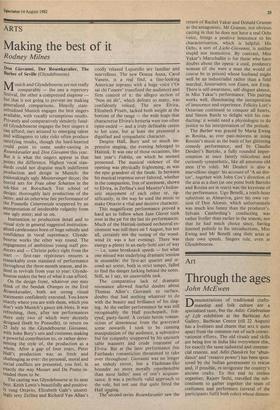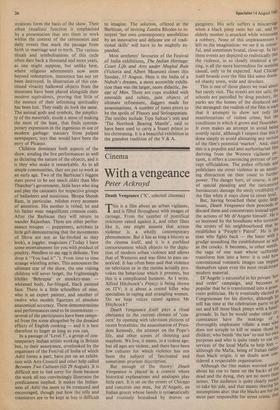Art
Through the ages
John McEwen
Demonstrations of traditional crafts- manship and folk culture are a specialised taste, but the Aditi: Celebration of Life exhibition at the Barbican Art Gallery, Barbican Centre (till 22 August) has a liveliness and charm that sets it quite apart from the common run of such conser- vationist efforts. The old rituals and skills are being lost in India like everywhere else, for exactly the same industrial and commer- cial reasons, and Aditi (Sanskrit for 'abun- dance' and 'creative power') has been spon- sored by the Indian government to rescue and, if possible, re-invigorate the country's ancient crafts. To this end its tireless organiser, Rajeev Sethi, travelled the sub- continent to gather together the team of craftsmen and performers (several of the participants fulfil both roles) whose demon-
strations form the basis of the show. Their often ritualistic function is emphasised by a presentation that sets them to work within the context of the ceremonies and daily events that mark the passage from birth to marriage and re-birth. The various rituals and symbolisations of this cycle often date back a thousand and more years, as one might suppose, but unlike here, where religious adornments now seem beyond redemption, innocence has not yet been destroyed. In illustration of this con- tinued vivacity hallowed objects from the museums have been placed alongside their modern equivalents, proving that little of the essence of their informing spirituality has been lost. They really do look the same. The animal gods and symbols, the simplici- ty of the materials, exude a sense of making the most of the least, that finds contem- porary expression in the ingenious re-use of modern garbage: statuary from pulped newspapers; toys that would have been the envy of Picasso.
Children dominate both aspects of the show, stealing the live performances as well as dictating the nature of the objects, and it is they who make it remarkable. As in all simple communities, they are put to work at an early age. Two of the Barbican's biggest stars prove to be not much older than Mrs Thatcher's government, little boys who sing and play the castanets for respective groups of balladeers and musicians. Bhopa Sheesh Ram, in particular, relishes every moment of attention. His mother is veiled; he and his father wear magnificent crimson coats. After the Barbican they will return to wander Rajasthan. There are other perfor- mance troupes — puppeteers, acrobats (a little girl demonstrating that the movements of Shiva are not as far-fetched as they look), a juggler, magicians (`Today I have some entertainment for you with product of poultry. Needless to say egg is delicate. You drop it "You had it".'). From time to time strange whistling arises. This announces the ultimate star of the show, the one visiting children will never forget, the frighteningly lifelike `Behrupia' or monkey-man whitened body, fur-fringed, black painted face. There is a little schoolboy of nine, who is an expert painter, and another of twelve who models figurines of absolute anatomical accuracy. These demonstrations and performances tend to be intermittent several of the participants have been remov- ed from the scene altogether by the dreaded effects of English cooking — and it is best therefore to linger as long as you can.
In a passage of 'Level 5', a group of con- temporary Indian artists working in Britain but, to their annoyance, overlooked by the organisers of the Festival of India of which Aditi forms a part, have put on an exhibi- tion with Arts Council and other help called Between Two Cultures (till 29 August). It is difficult not to feel sorry for them because the work all too convincingly illustrates the predicament implied. It makes the Indian- ness of Aditi the more to be treasured and encouraged, though just how the telly and transistors are to be kept at bay is difficult to imagine. The solution, offered at the Barbican, of inviting Zandra Rhodes to in- terpret 'her own contemporary sensibilities by an innovative and delicate use of tradi- tional skills' will have to be mightily ex- panded.
Most aesthetes' favourite of the Festival of India exhibitions, The Indian Heritage: Court Life and Arts under Mughal Rule (Victoria and Albert Museum) closes this Sunday, 15 August. Here is the India of a Nabob's dreams, a more accessible exhibi- tion than was the larger, more didactic, Im- age of Man. There are cups studded with emeralds and rubies, jade objects of ultimate refinement, daggers made for assassinations. A number of items prove to be the spoils of Plassey and Seringapatam. The textiles include Tipu Sultan's tent and `The Northesk Bearing Mantle', said to have been used to carry a Stuart prince to his christening. It is a beautiful exhibition in the grandest tradition of the V & A.



































 Previous page
Previous page